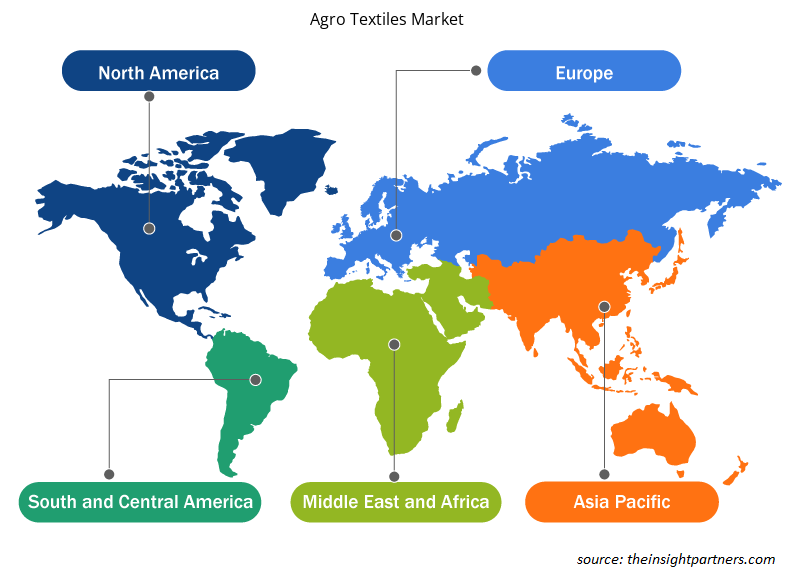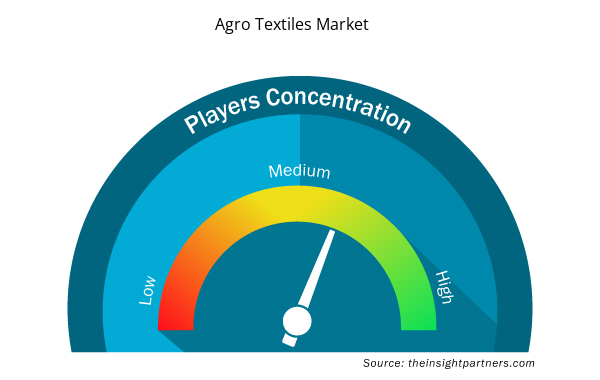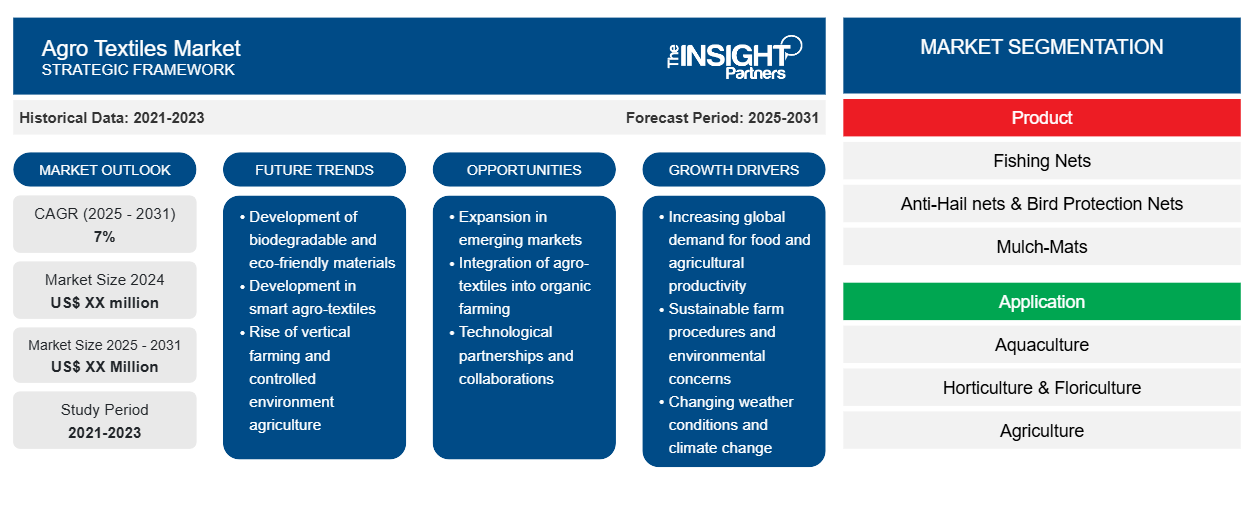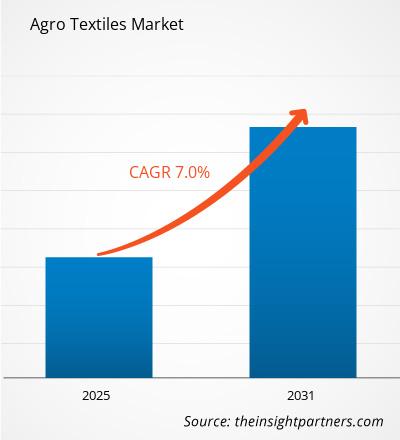Der Markt für Agrartextilien dürfte zwischen 2023 und 2031 eine durchschnittliche jährliche Wachstumsrate (CAGR) von 7 % verzeichnen, wobei die Marktgröße von XX Millionen US-Dollar im Jahr 2023 auf XX Millionen US-Dollar im Jahr 2031 anwachsen wird.
Der Bericht ist nach Produkten segmentiert (Fischernetze, Hagelschutznetze und Vogelschutznetze, Mulchmatten, Schattennetze und andere). Der Bericht präsentiert außerdem Analysen basierend auf der Anwendung (Aquakultur, Gartenbau und Blumenzucht, Landwirtschaft und andere). Die globale Analyse ist weiter auf regionaler Ebene und in die wichtigsten Länder unterteilt. Die Marktgröße und -prognose auf globaler, regionaler und Länderebene für alle wichtigen Marktsegmente werden im Rahmen abgedeckt. Der Bericht bietet den Wert in USD für die oben genannte Analyse und die Segmente. Der Bericht bietet wichtige Statistiken zum Marktstatus der wichtigsten Marktteilnehmer und bietet Markttrends und -chancen.
Zweck des Berichts
Der Bericht Agro Textiles Market von The Insight Partners zielt darauf ab, die aktuelle Landschaft und das zukünftige Wachstum sowie die wichtigsten treibenden Faktoren, Herausforderungen und Chancen zu beschreiben. Dies wird verschiedenen Geschäftspartnern Einblicke geben, wie zum Beispiel:
- Technologieanbieter/-hersteller: Um die sich entwickelnde Marktdynamik zu verstehen und die potenziellen Wachstumschancen zu kennen, damit sie fundierte strategische Entscheidungen treffen können.
- Investoren: Durchführung einer umfassenden Trendanalyse hinsichtlich der Marktwachstumsrate, der finanziellen Marktprognosen und der Chancen entlang der Wertschöpfungskette.
- Regulierungsbehörden: Zur Regulierung von Richtlinien und Überwachungsaktivitäten auf dem Markt mit dem Ziel, Missbrauch zu minimieren, das Vertrauen der Anleger zu bewahren und die Integrität und Stabilität des Marktes aufrechtzuerhalten.
Marktsegmentierung für Agrartextilien
Produkt
- Fischernetze
- Hagelschutznetze & Vogelschutznetze
- Mulchmatten
- Schattennetze
Anwendung
- Aquakultur
- Gartenbau & Blumenzucht
- Landwirtschaft
Passen Sie diesen Bericht Ihren Anforderungen an
Sie erhalten kostenlose Anpassungen an jedem Bericht, einschließlich Teilen dieses Berichts oder einer Analyse auf Länderebene, eines Excel-Datenpakets sowie tolle Angebote und Rabatte für Start-ups und Universitäten.
- Holen Sie sich die wichtigsten Markttrends aus diesem Bericht.Dieses KOSTENLOSE Beispiel umfasst eine Datenanalyse von Markttrends bis hin zu Schätzungen und Prognosen.
Wachstumstreiber auf dem Agrartextilmarkt
- Steigende globale Nachfrage nach Nahrungsmitteln und landwirtschaftlicher Produktivität: Die globale Nachfrage nach Nahrungsmitteln steigt und ist daher einer der Haupttreiber des Agrotextilmarktes. Die Bevölkerung wächst; daher steigt auch die Nachfrage nach höherer landwirtschaftlicher Produktivität weiter. Agrotextilien wie Netze, Beschattungsmaterialien und Mulchfolien tragen zur Optimierung der Ernteerträge bei, indem sie die Pflanzen vor Schädlingen, Krankheiten und extremen Wetterbedingungen schützen. Sie werden auch verwendet, um Temperatur und Luftfeuchtigkeit zu regulieren und so eine Umgebung zu schaffen, die das Pflanzenwachstum unterstützt. Diese Bedingung ist der Grund für die Einführung von Agrotextilien, die sich weltweit durchsetzen.
- Nachhaltige landwirtschaftliche Verfahren und Umweltbelange: Da Nachhaltigkeit allmählich zum Mantra der Landwirtschaft wird, werden Agrotextilien zunehmend in den Vordergrund gerückt. Beispielsweise ersetzen biologisch abbaubare Mulchfolien herkömmliche Mulchfolien aus Kunststoff und reduzieren so den Kunststoffabfall auf landwirtschaftlichen Feldern. Als Teil einer ressourceneffizienten Landwirtschaft zielen diese Agrotextilien, ergänzt durch Netze zur Schädlingsbekämpfung und Schattenstoffe, darauf ab, die Abhängigkeit von chemischen Pestiziden und Düngemitteln zu verringern, deren Verwendung die Umwelt schädigt. Angesichts der zunehmenden Nachfrage nach ökologisch nachhaltiger Landwirtschaft werden Agrotextilien als praktikable Alternativen für eine ressourceneffiziente Landwirtschaft angesehen.
- Veränderte Wetterbedingungen und Klimawandel: Der Klimawandel beeinträchtigt weiterhin die Regelmäßigkeit und Intensität von Wettermustern oder -phänomenen, darunter Dürren, Überschwemmungen und extreme Temperaturen. Die wichtigste Lösung zur Verhinderung solcher Umweltschäden sind Agrotextilien oder Schutznetze, Schattentücher, wetterfeste Abdeckungen usw. Solche Strukturen können als Schutzvorrichtungen gegen widrige Umweltbedingungen dienen, die Bodenfeuchtigkeit aufrechterhalten und die Temperatur regulieren. Das zunehmende Auftreten extremer Wetterbedingungen bedeutet daher, dass Agrotextilien zunehmend benötigt werden, da sie sehr landwirtschaftlich nutzbare innovative Ansätze zur Reaktion auf klimatische Schwankungen bieten.
Zukünftige Trends auf dem Agrartextilmarkt
- Entwicklung biologisch abbaubarer und umweltfreundlicher Materialien: Nachhaltige Entwicklung ist derzeit eines der wichtigsten Themen in der Landwirtschaft und wird sicherlich den zukünftigen weltweiten Markt für Agrartextilien dominieren. Man erwartet, dass die Agrartextilindustrie „bald“ auf biologisch abbaubare und umweltfreundliche Materialien umsteigen wird. In der gesamten Branche ist das Bewusstsein dafür gestiegen, dass solche biologisch abbaubaren Agrartextilien – Sieb- und Mulchfolien, Netze aus Naturfasern oder biologisch abbaubarem Polymer – wertvoll sind, weil sie den ökologischen Fußabdruck landwirtschaftlicher Betriebe fast automatisch verringern. Sie reduzieren die Ansammlung von Kunststoffabfällen, indem sie sich nach der Verwendung während der Produktion weiter zersetzen. Man geht davon aus, dass die weitere Entwicklung und Einführung solcher Agrartextilien dem Markt große Impulse verleihen wird.
- Entwicklung intelligenter Agrartextilien: Ein weiterer bedeutender Effekt auf die Zukunft des Marktes ist die technologische Integration von Agrartextilien. Nach und nach werden intelligente Agrartextilien oder Textilien, die Veränderungen der Umweltbedingungen wahrnehmen und darauf reagieren können, immer häufiger zum Einsatz kommen. Diese Art von Kleidungsstücken wird mit Sensoren ausgestattet, die Feuchtigkeit und Temperatur im Boden sowie Schädlingsdaten messen, sodass Landwirte je nach Ernteertrag den Bedarf an Bewässerung und Schädlingsbekämpfung erkennen können. In Bezug auf Präzisionslandwirtschaft und digitale Landwirtschaft kann man davon ausgehen, dass sich eine solche Integration nur verstärken wird, da intelligente Agrartextilien immer alltäglicher werden.
- Aufstieg des vertikalen Anbaus und der Landwirtschaft in kontrollierter Umgebung: Solche Umweltveränderungen aufgrund landwirtschaftlich kontrollierter Strömungen eröffnen weltweit neue Perspektiven für Agrotextilien. Mit zunehmender Urbanisierung und abnehmendem Ackerland wird der vertikale Anbau – also der Anbau von Pflanzen in gestapelten Schichten – oder in kontrollierten Umgebungen für die meisten zur Realität. Agrotextilien, darunter reflektierende Folien, UV-blockierende Materialien und temperaturregulierende Stoffe, tragen alle zu diesen Systemen bei, indem sie optimale Wachstumsbedingungen schaffen. Mit der zunehmenden Akzeptanz dieser Anbausysteme wird eine Nachfrage nach spezielleren Agrotextilien entstehen, die speziell für den Einsatz im vertikalen Anbau und in der Landwirtschaft in kontrollierter Umgebung hergestellt werden.
Marktchancen für Agrartextilien
- Expansion in Schwellenmärkten: Dies ist sicherlich richtig, denn obwohl Asien-Pazifik, Afrika und Lateinamerika sich im Umbruch befinden, bieten sie das größte Potenzial für den globalen Agrartextilmarkt. Die meisten dieser Länder sind von der Landwirtschaft abhängig und setzen nun auf Agrartextilien, um die Ernteerträge zu verbessern und andere klimabedingte Schocks für die Landwirte zu bewältigen. Eine erhöhte Nachfrage nach Agrartextilien dürfte auf die zunehmende Kultur der modernen Landwirtschaft und nachhaltige Praktiken der Landwirte zurückzuführen sein, insbesondere in diesen Bereichen. Wenn die Regierung nachhaltige landwirtschaftliche Praktiken und die Ernährungssicherheit in Entwicklungsländern fördert und subventioniert, wird das Marktwachstum tendenziell noch weiter gefördert.
- Integration von Agrotextilien in den ökologischen Landbau: Heutzutage erfreut sich der ökologische Landbau aufgrund seiner Beliebtheit bei Verbrauchern zunehmender Beliebtheit, die ein viel stärkeres Bewusstsein für den Einsatz von Pestiziden in Lebensmitteln und folglich eine Vorliebe für Bioprodukte entwickelt haben. Die anderen Hauptfunktionen von Agrotextilien im ökologischen Landbau sind Schädlingsbekämpfung, Bodenschutz und Feuchtigkeitsspeicherung von Pflanzen ohne Chemikalien. Diese weltweit zunehmende Praxis des ökologischen Landbaus ist die größte Chance für den Agrotextilmarkt. Eine Zunahme des ökologischen Landbaus würde die Nachfrage nach Agrotextilien für den ökologischen Landbau erhöhen. Dies würde eine beträchtliche Nische für Hersteller von Ökotextilien darstellen.
- Technologische Partnerschaften und Kooperationen: Dies ist eine der größten Marktchancen für Agrotextilhersteller und Technologieentwickler. Die Integration neuer Materialien wie intelligente Stoffe und nanobeschichtete Textilien würde die Funktionalität und Leistung von Agrotextilien verbessern. Solche Kooperationen könnten Textilien hervorbringen, die eine hohe Wasserspeicherfähigkeit aufweisen, UV-Schutz bieten und mit Sensoren ausgestattet sind, um die Ernte besser überwachen zu können. Diese Partnerschaften zwischen Textilherstellern und Technologieunternehmen werden ein wichtiger Weg für Innovation und Markterweiterung sein, da die Nachfrage nach hochtechnologischen, multifunktionalen Agrotextilien steigt.
Regionale Einblicke in den Agrartextilienmarkt
Die regionalen Trends und Faktoren, die den Agrartextilmarkt im Prognosezeitraum beeinflussen, wurden von den Analysten von Insight Partners ausführlich erläutert. In diesem Abschnitt werden auch die Marktsegmente und die Geografie des Agrartextilmarkts in Nordamerika, Europa, im asiatisch-pazifischen Raum, im Nahen Osten und Afrika sowie in Süd- und Mittelamerika erörtert.

- Erhalten Sie regionale Daten zum Agrartextilienmarkt
Umfang des Marktberichts für Agrartextilien
| Berichtsattribut | Details |
|---|---|
| Marktgröße im Jahr 2023 | XX Millionen US-Dollar |
| Marktgröße bis 2031 | XX Millionen US-Dollar |
| Globale CAGR (2023 - 2031) | 7 % |
| Historische Daten | 2021-2022 |
| Prognosezeitraum | 2024–2031 |
| Abgedeckte Segmente | Nach Produkt
|
| Abgedeckte Regionen und Länder | Nordamerika
|
| Marktführer und wichtige Unternehmensprofile |
|
Dichte der Akteure auf dem Agrartextilmarkt: Auswirkungen auf die Geschäftsdynamik verstehen
Der Markt für Agrartextilien wächst rasant, angetrieben durch die steigende Nachfrage der Endverbraucher aufgrund von Faktoren wie sich entwickelnden Verbraucherpräferenzen, technologischen Fortschritten und einem größeren Bewusstsein für die Vorteile des Produkts. Mit steigender Nachfrage erweitern Unternehmen ihr Angebot, entwickeln Innovationen, um die Bedürfnisse der Verbraucher zu erfüllen, und nutzen neue Trends, was das Marktwachstum weiter ankurbelt.
Die Marktteilnehmerdichte bezieht sich auf die Verteilung der Firmen oder Unternehmen, die in einem bestimmten Markt oder einer bestimmten Branche tätig sind. Sie gibt an, wie viele Wettbewerber (Marktteilnehmer) in einem bestimmten Marktraum im Verhältnis zu seiner Größe oder seinem gesamten Marktwert präsent sind.
Die wichtigsten auf dem Markt für Agrartextilien tätigen Unternehmen sind:
- Tama
- SRF GmbH
- Belton Industries
- Beaulieu Technische Textilien
Haftungsausschluss : Die oben aufgeführten Unternehmen sind nicht in einer bestimmten Reihenfolge aufgeführt.

- Überblick über die wichtigsten Akteure auf dem Markt für Agrartextilien
Wichtige Verkaufsargumente
- Umfassende Abdeckung: Der Bericht deckt die Analyse von Produkten, Dienstleistungen, Typen und Endbenutzern des Agrartextilien-Marktes umfassend ab und bietet einen ganzheitlichen Überblick.
- Expertenanalyse: Der Bericht basiert auf dem umfassenden Verständnis von Branchenexperten und Analysten.
- Aktuelle Informationen: Der Bericht stellt durch die Abdeckung aktueller Informationen und Datentrends Geschäftsrelevanz sicher.
- Anpassungsoptionen: Dieser Bericht kann angepasst werden, um spezifische Kundenanforderungen zu erfüllen und die Geschäftsstrategien optimal anzupassen.
Der Forschungsbericht zum Markt für Agrartextilien kann daher dabei helfen, die Branchensituation und Wachstumsaussichten zu entschlüsseln und zu verstehen. Obwohl es einige berechtigte Bedenken geben kann, überwiegen die allgemeinen Vorteile dieses Berichts tendenziell die Nachteile.
- Historische Analyse (2 Jahre), Basisjahr, Prognose (7 Jahre) mit CAGR
- PEST- und SWOT-Analyse
- Marktgröße Wert/Volumen – Global, Regional, Land
- Branche und Wettbewerbsumfeld
- Excel-Datensatz



Report Coverage
Revenue forecast, Company Analysis, Industry landscape, Growth factors, and Trends

Segment Covered
This text is related
to segments covered.

Regional Scope
North America, Europe, Asia Pacific, Middle East & Africa, South & Central America

Country Scope
This text is related
to country scope.
Häufig gestellte Fragen
Smart and responsive textiles is expected to be the key market trends
Based on geography, Asia Pacific held the largest share of the agro textiles market due to the well-established agriculture industry across the region, coupled with continuous growth and development
Based on product, the mulch-mats segment is expected to witness the fastest growth during the forecast period
Tama;SRF Limited;Belton Industries;Beaulieu Technical Textiles;Diatex;Meyabond Industry & Trading (Beijing)Co., Ltd.;Zhongshan Hongjun Nonwoven Co., Ltd.;Hy-Tex (UK) Limited;CAPATEX LTD;B&V Agro Irrigation Co
Increasing demand for food security is driving the market growth
The Agro Textiles Market is estimated to witness a CAGR of 7% from 2023 to 2031
Trends and growth analysis reports related to Chemicals and Materials : READ MORE..
The List of Companies
1. Tama
2. SRF Limited
3. Belton Industries
4. Beaulieu Technical Textiles
5. Diatex
6. Meyabond Industry & Trading (Beijing) Co., Ltd.
7. Zhongshan Hongjun Nonwoven Co., Ltd.
8. Hy-Tex (UK) Limited
9. CAPATEX LTD
10. B&V Agro Irrigation Co
The Insight Partners performs research in 4 major stages: Data Collection & Secondary Research, Primary Research, Data Analysis and Data Triangulation & Final Review.
- Data Collection and Secondary Research:
As a market research and consulting firm operating from a decade, we have published and advised several client across the globe. First step for any study will start with an assessment of currently available data and insights from existing reports. Further, historical and current market information is collected from Investor Presentations, Annual Reports, SEC Filings, etc., and other information related to company’s performance and market positioning are gathered from Paid Databases (Factiva, Hoovers, and Reuters) and various other publications available in public domain.
Several associations trade associates, technical forums, institutes, societies and organization are accessed to gain technical as well as market related insights through their publications such as research papers, blogs and press releases related to the studies are referred to get cues about the market. Further, white papers, journals, magazines, and other news articles published in last 3 years are scrutinized and analyzed to understand the current market trends.
- Primary Research:
The primarily interview analysis comprise of data obtained from industry participants interview and answers to survey questions gathered by in-house primary team.
For primary research, interviews are conducted with industry experts/CEOs/Marketing Managers/VPs/Subject Matter Experts from both demand and supply side to get a 360-degree view of the market. The primary team conducts several interviews based on the complexity of the markets to understand the various market trends and dynamics which makes research more credible and precise.
A typical research interview fulfils the following functions:
- Provides first-hand information on the market size, market trends, growth trends, competitive landscape, and outlook
- Validates and strengthens in-house secondary research findings
- Develops the analysis team’s expertise and market understanding
Primary research involves email interactions and telephone interviews for each market, category, segment, and sub-segment across geographies. The participants who typically take part in such a process include, but are not limited to:
- Industry participants: VPs, business development managers, market intelligence managers and national sales managers
- Outside experts: Valuation experts, research analysts and key opinion leaders specializing in the electronics and semiconductor industry.
Below is the breakup of our primary respondents by company, designation, and region:

Once we receive the confirmation from primary research sources or primary respondents, we finalize the base year market estimation and forecast the data as per the macroeconomic and microeconomic factors assessed during data collection.
- Data Analysis:
Once data is validated through both secondary as well as primary respondents, we finalize the market estimations by hypothesis formulation and factor analysis at regional and country level.
- Macro-Economic Factor Analysis:
We analyse macroeconomic indicators such the gross domestic product (GDP), increase in the demand for goods and services across industries, technological advancement, regional economic growth, governmental policies, the influence of COVID-19, PEST analysis, and other aspects. This analysis aids in setting benchmarks for various nations/regions and approximating market splits. Additionally, the general trend of the aforementioned components aid in determining the market's development possibilities.
- Country Level Data:
Various factors that are especially aligned to the country are taken into account to determine the market size for a certain area and country, including the presence of vendors, such as headquarters and offices, the country's GDP, demand patterns, and industry growth. To comprehend the market dynamics for the nation, a number of growth variables, inhibitors, application areas, and current market trends are researched. The aforementioned elements aid in determining the country's overall market's growth potential.
- Company Profile:
The “Table of Contents” is formulated by listing and analyzing more than 25 - 30 companies operating in the market ecosystem across geographies. However, we profile only 10 companies as a standard practice in our syndicate reports. These 10 companies comprise leading, emerging, and regional players. Nonetheless, our analysis is not restricted to the 10 listed companies, we also analyze other companies present in the market to develop a holistic view and understand the prevailing trends. The “Company Profiles” section in the report covers key facts, business description, products & services, financial information, SWOT analysis, and key developments. The financial information presented is extracted from the annual reports and official documents of the publicly listed companies. Upon collecting the information for the sections of respective companies, we verify them via various primary sources and then compile the data in respective company profiles. The company level information helps us in deriving the base number as well as in forecasting the market size.
- Developing Base Number:
Aggregation of sales statistics (2020-2022) and macro-economic factor, and other secondary and primary research insights are utilized to arrive at base number and related market shares for 2022. The data gaps are identified in this step and relevant market data is analyzed, collected from paid primary interviews or databases. On finalizing the base year market size, forecasts are developed on the basis of macro-economic, industry and market growth factors and company level analysis.
- Data Triangulation and Final Review:
The market findings and base year market size calculations are validated from supply as well as demand side. Demand side validations are based on macro-economic factor analysis and benchmarks for respective regions and countries. In case of supply side validations, revenues of major companies are estimated (in case not available) based on industry benchmark, approximate number of employees, product portfolio, and primary interviews revenues are gathered. Further revenue from target product/service segment is assessed to avoid overshooting of market statistics. In case of heavy deviations between supply and demand side values, all thes steps are repeated to achieve synchronization.
We follow an iterative model, wherein we share our research findings with Subject Matter Experts (SME’s) and Key Opinion Leaders (KOLs) until consensus view of the market is not formulated – this model negates any drastic deviation in the opinions of experts. Only validated and universally acceptable research findings are quoted in our reports.
We have important check points that we use to validate our research findings – which we call – data triangulation, where we validate the information, we generate from secondary sources with primary interviews and then we re-validate with our internal data bases and Subject matter experts. This comprehensive model enables us to deliver high quality, reliable data in shortest possible time.


 Holen Sie sich ein kostenloses Muster für diesen Bericht
Holen Sie sich ein kostenloses Muster für diesen Bericht